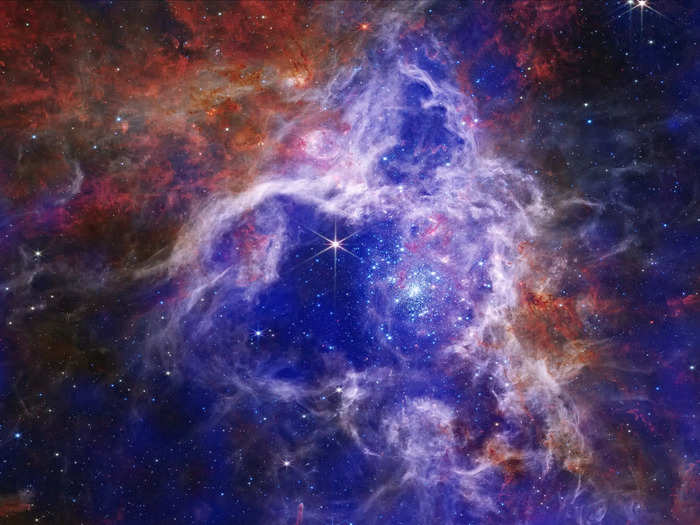
Messier 74, nicknamed "the Phantom Galaxy" for its dimness, comes to life when Chandra revealed its X-ray activity (purple) alongside observations from Hubble and Webb.X-ray: NASA/CXC/SAO; Optical: NASA/ESA/STScI; IR NASA/ESA/CSA/STScI, J. Lee and the PHANGS-JWST Team; Image Processing: N. Wolk and K. Arcand
One of NASA's top space telescopes may be facing an untimely end due to budget cuts.
The Chandra X-ray Observatory has been orbiting Earth for 25 years, peering at the universe in X-ray light that's invisible to the human eye.
Through its stunning images, the telescope has revealed that the cosmos is teeming with black holes, discovered direct evidence for the existence of dark matter, and spotted the light of colliding neutron stars that warped space-time.
Check out some of Chandra's best photos, including collaborations with the Hubble and James Webb space telescopes.

The observatory cost NASA about $2.2 billion to build and launch, and it has paid off.
"For many years it was the most productive mission in NASA's program if measured in publications/dollar spent," Thomas Zurbuchen, who was the Associate Administrator of NASA's Science Mission Directorate from 2016 to 2022, told Business Insider in an email.

Over the ensuing years, the budget proposes to give the observatory $26.6 million annually until a drastic plummet to $5.2 million in 2029.

In fact, Chandra's operating team says that's just the amount it would need to decommission the telescope and end its operations.

It's both the most distant black hole ever detected, and at a stage of infancy that had never been seen before.

For example, Chandra revealed a sea of young stars burning bright in X-rays across the above Webb image of the iconic Pillars of Creation, a cloud formation constantly birthing new stars.
"Often you get like a gas cloud that's glowing, and then there's this X-ray source in the middle that's pumping the energy into it that's causing it to glow," Jonathan McDowell, an astrophysicist who leads science data systems for Chandra, told Business Insider. "If you don't have Chandra, you can't see that. So you're missing a big part of the story."

That's how Chandra discovered that the supermassive black hole at the center of our galaxy is spinning rapidly.

The telescope clearly captured the X-ray emissions of a neutron-star collision in 2017. It was the first — and, so far, only — time that anyone had seen the light from a violent cosmic collision that sent gravitational waves (ripples in space-time) through Earth.
Scientists expect to discover thousands more such mysterious flash-in-a-pan events with the advent of the Rubin Observatory, which is set to begin scanning the entire southern sky next year.

When Rubin discovers an explosion unfolding rapidly in the distant universe, telescopes worldwide will have to turn their lens to capture the phenomenon in visible light, infrared, radio, gamma rays, and X-rays. Without Chandra, a piece of the puzzle will be missing.
Losing Chandra would be "a devastating blow" and "a disaster" for X-ray astronomy, astrophysicists said after the budget announcement, according to Space.com.

Congress put a cap on its spending for 2024 and 2025, slashing its science budget by half a billion dollars while the agency invests more in its Artemis moon program.
In the astrophysics division, most missions escaped the cuts this year. In fact, plans for the ambitious alien-life-hunting Habitable Worlds Observatory for the 2040s got a boost. To offset that, NASA proposed a 5% cut to Hubble's budget and the extreme cuts to Chandra.

The document said the spacecraft has degraded over time, requiring more intense management to keep its temperatures low enough to operate. That complicates scheduling and increases mission costs beyond what NASA can afford, the document says.

In a letter to Chandra astronomers, he wrote that "there has been only one instance in which the cost has increased to help manage temperatures," and that was a 1% increase in costs so the project could hire two additional people for the flight team.

If the current budget proposal holds, and Chandra has to begin its end when the 2025 fiscal year starts in October, that will likely lead to layoffs.
That's another crisis for X-ray astronomy. If Chandra ends, many jobs in the field will disappear until NASA launches its next major space-based X-ray telescope, Lynx, in about a decade at the earliest.
"There are just simply not going to be people who can do this," X-ray astronomer David Pooley told USA Today.


"We will continue to strongly make the case for the continued full support of Chandra, which the astrophysics community recognizes as a highly functioning facility that provides transformational science and crucial support to many of NASA's primary astrophysics goals," Slane wrote.
 2 states where home prices are falling because there are too many houses and not enough buyers
2 states where home prices are falling because there are too many houses and not enough buyers US buys 81 Soviet-era combat aircraft from Russia's ally costing on average less than $20,000 each, report says
US buys 81 Soviet-era combat aircraft from Russia's ally costing on average less than $20,000 each, report says A couple accidentally shipped their cat in an Amazon return package. It arrived safely 6 days later, hundreds of miles away.
A couple accidentally shipped their cat in an Amazon return package. It arrived safely 6 days later, hundreds of miles away. 9 health benefits of drinking sugarcane juice in summer
9 health benefits of drinking sugarcane juice in summer
 10 benefits of incorporating almond oil into your daily diet
10 benefits of incorporating almond oil into your daily diet
 From heart health to detoxification: 10 reasons to eat beetroot
From heart health to detoxification: 10 reasons to eat beetroot

Copyright © 2024. Times Internet Limited. All rights reserved.For reprint rights. Times Syndication Service.